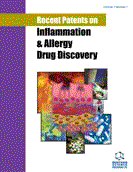Abstract
The main COX inhibitors are the non-steroidal anti-inflammatory drugs (NSAIDs). NSAIDs exert antiinflammatory and analgesic effects through the inhibition of prostaglandin synthesis by blocking COX activity. Currently two COX isoenzymes are known, COX-1 and COX-2. Prostaglandins influenced by COX-1 maintain the integrity of the gastric mucosa. On the other hand, prostaglandins influenced by COX-2 mediate the inflammatory process. The common anti-inflammatory drugs (like aspirin, ibuprofen, and naproxen) all act by blocking the action of both the COX-1 and COX-2 enzymes. The COX-2 inhibitors represent a new class of drugs that do not affect COX-1, but selectively block COX-2. This selective action provides the benefits of reducing inflammation without irritating the stomach. This review will focus on the most recent developments published in the field, paying particular attention to promising COX-2 inhibitors, their chemistry and biological evaluation, and to new chemical and pharmaceutical processes. Moreover, we will discuss recent patents of structural analogs of the COX-2 inhibitors celecoxib and valdecoxib, and novel potential pyridazine, triazole, indole, thione derivatives as a future target for the treatment of inflammation, pain and other diseases.
Keywords: Patents, COX-2, anti-inflammatory drugs
 7
7


















